

Indigo dye. Indigo dye is an organic compound with a distinctive blue color (see indigo).

Historically, indigo was a natural dye extracted from plants, and this process was important economically because blue dyes were once rare. Nearly all indigo dye produced today – several thousand tons each year – is synthetic. It is the blue of blue jeans. Uses[edit] Baptisia australis - How to Grow and Care for Baptisia australis, Wild Blue Indigo. Overview: Baptisia australis, or blue false indigo is a native American beauty.
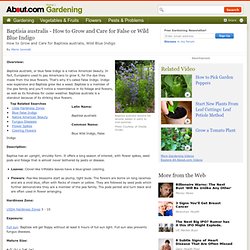
In fact, Europeans used to pay Americans to grow it, for the dye they made from the blue flowers. That's why it's called False Indigo. Indigo was expensive and Baptisia grew like a weed. Baptisia is a member of the pea family and you’ll notice a resemblance in its foliage and flowers, as well as its fondness for cooler weather. Latin Name: Baptisia australis Common Name: Blue Wild Indigo, False Indigo Description: Baptisa has an upright, shrubby form. Leaves: Clover-like trifoliate leaves have a blue-green coloring.
Hardiness Zone: USDA Hardiness Zones 3 - 10 Exposure: Full sun. Mature Size: 4-5' (h) x 3-4' (w) Bloom Period: Late Spring - Early Summer Suggested Varieties: Purple Smoke Baptisia X ‘Purple Smoke- A hybrid with a purple eye in the center of the blue flowers. Pelargonium sidoides. Pelargonium sidoides is a medicinal plant native to South Africa.
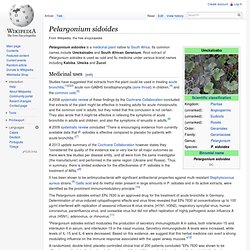
Its common names include Umckaloabo and South African Geranium. Root extract of Pelargonium sidoides is used as cold and flu medicine under various brand names including Kaloba, Umcka and Zucol. Medicinal uses[edit] Studies have suggested that extracts from the plant could be used in treating acute bronchitis,[1][2][3] acute non-GABHS tonsillopharyngitis (sore throat) in children,[4] and the common cold.[5] Codonopsis pilosula. Codonopsis pilosula (Chinese: 党参; pinyin: dǎngshēn), also known as dang shen or poor man's ginseng, is a perennial species of flowering plant in the bellflower family.

It is native to Asia, where it grows in forests, meadows, and scrub.[1] Description[edit] The plant produces twining stems up to 2 meters long. It has lateral branches with alternately arranged leaves and small branchlets with oppositely arranged leaves. The ovate leaves are up to 7.3 centimeters long and are usually coated with short hairs. Traditional uses[edit] Leaves Dried Codonopsis pilosula root. Codonopsis: Poor Man's Ginseng but Delicious. After years of reading about codonopsis in books on Chinese medicinal herbs, I had the occasion to eat this delicious root at a Korean restaurant where it was prepared in an exquisite barbeque sauce and served on a delightful platter.
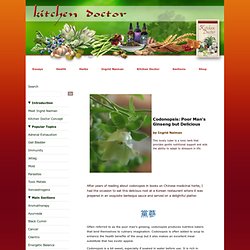
Often referred to as the poor man's ginseng, codonopsis produces nutritive tubers that lend themselves to culinary imagination. Codonopsis is often added to soup to enhance the health benefits of the soup but it also makes an excellent meat substitute that has exotic appeal. Codonopsis is a bit sweet, especially if soaked in water before use.
Health benefits of fennel. Fennel is a herb native to the Mediterranean region which gained popularity ever since the Middle Ages when it was cultivated near monasteries.
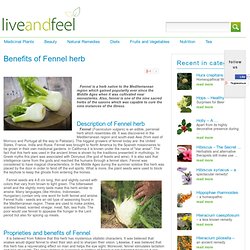
Also, fennel is one of the nine sacred herbs of the saxons which was capable to cure the nine instances of the illness. Description of Fennel herb Fennel (Foeniculum vulgare) is an edible, perrenial herb which resembles dill. It was discovered in the Mediterranean region and south-east Asia (from east of Morroco and Portugal all the way to Pakistan). The biggest growers of fennel today are: the United States, France, India and Rusia. How to Grow Fennel, a Herb and a Vegetable by The Gardener's Network. Skullcap herb uses and description. Scutellaria lateriflora Skullcap Herbal Use and Medicinal Properties Skullcap is a powerful medicinal herb, it is used in alternative medicine as an anti-inflammatory, antispasmodic, slightly astringent, emmenagogue, febrifuge, nervine, sedative and strongly tonic.
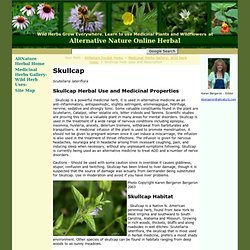
Some valuable constituents found in the plant are Scutellarin, Catalpol, other Volatile oils, bitter iridoids and Tannins. Scientific studies are proving this to be a valuable plant in many areas for mental disorders. How to Grow Skullcap. Overview There are several varieties of skullcap native to North America.

Two are Scutellaria lateriflora and Scutellaria incana. Both are members of the family Lamiaceae, which includes mints, but are showier. Found growing wild in moist thickets, marshes and woods, skullcap's medicinal use dates back centuries. Chickweed herb uses, pictures, herbal remedy for weight loss. Chickweeds.
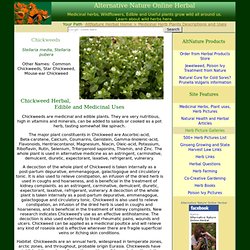
How to Grow Chickweed. Overview One of the great shames of modern landscaping is chickweed's relegation to the category of unwanted plants.
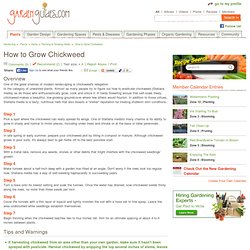
Almost as many people try to figure out how to eradicate chickweed (Stellaria media) as do those who enthusiastically grow, cook and utilize it. A hardy flowering annual that self-sows freely, chickweed makes a beautiful, low-growing groundcover where few others would flourish. In addition to those virtues, Stellaria media is a tasty, nutritious herb that also boasts a "stellar" reputation for treating stubborn skin conditions. Step 1 Pick a spot where the chickweed can really spread its wings. Step 2 In late spring or early summer, prepare your chickweed plot by tilling in compost or manure. Step 3 With a metal rake, remove any weeds, stones or other debris that might interfere with the chickweed seedlings' growth. Step 4 Make furrows about a half-inch deep with a garden hoe tilted at an angle. Step 5 Turn a hose onto its lowest setting and soak the furrows.
Medicinal Herb Seeds for Planting.